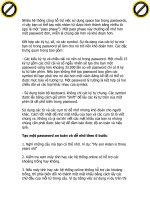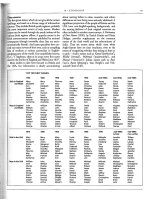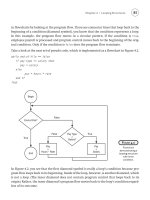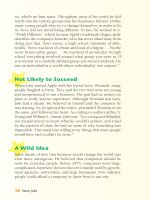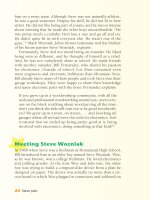Steve Jobs.Other books in the People in the News series phần 4 pot
Bạn đang xem bản rút gọn của tài liệu. Xem và tải ngay bản đầy đủ của tài liệu tại đây (1.02 MB, 10 trang )
30
Steve Jobs
College Dropout
After one semester at Reed, Steve dropped out. Unlike most col-
lege dropouts, he did not leave the campus or stop attending
classes. He just stopped paying tuition and dorm fees. With his
characteristic rebelliousness, he decided he could have the same
experience for free. He slept on the floor of Kottke’s dorm room
and attended classes in subjects that interested him without get-
ting credit for them. He made friends with the dean of students,
Jack Dudman, who was so impressed with the boy that he ignored
his illegal actions. Dudman explains: “Steve had a very inquiring
While at college, Jobs studied Eastern religions and
became a Zen Buddhist.
Searching for Answers
31
mind that was enormously attractive. You wouldn’t get away with
bland statements. He refused to accept automatically perceived
truths. He wanted to examine everything himself.”
24
In this manner, Steve was able to satisfy his intellectual curios-
ity without being forced to sit through required classes that did
not interest him. Instead, he attended classes that he might not
have experienced had he followed a standard course of study.
For instance, he attended a calligraphy class, which influenced
his idea that Apple computers have multiple fonts in the future.
Jobs recalls:
After six months . . . I had no idea what I wanted to do
with my life and no idea how college was going to help me
figure it out. And here I was spending all of the money my
parents had saved their entire life. So I decided to drop out
and trust that it would all work out OK. It was pretty scary
at the time, but looking back it was one of the best deci-
The 1970s
M
any of the changes that began in the 1960s, a decade
marked by social upheaval, continued to grow in the
1970s. For instance, the hippie culture, which rejected tradi-
tional social values and materialism, continued into the early
part of the 1970s. Hippies were trying to change society, while
experimenting with alternative lifestyles such as communal
living, vegetarianism, Eastern religions such as Zen Buddhism,
and using psychedelic drugs. The environmental movement
also became popular in the 1970s.
The 1970s also witnessed an explosion in technology. The
laser, integrated circuit, microprocessor, personal computer,
floppy disk, ink-jet printer, pocket calculator, video game,
microwave oven, and video cassette recorders were all devel-
oped in the 1970s. The fiber optics industry, which transformed
communications forever, also had its start in the 1970s.
32
Steve Jobs
sions I ever made. The minute I dropped out I could stop
taking the required classes that didn’t interest me, and begin
dropping in on the ones that looked interesting. It wasn’t all
romantic. I didn’t have a dorm room, so I slept on the floor
in friends’ rooms, I returned coke bottles for the 5¢ deposits
to buy food with, and I would walk the 7 miles across town
every Sunday night to get one good meal a week at the Hare
Krishna temple. I loved it. And much of what I stumbled
into by following my curiosity and intuition turned out to
be priceless later on.
25
A Man with a Goal
In 1973, Robert Friedland went to India. Here, he claimed, he
had finally found the meaning of life. Steve decided to go to India,
After dropping out of college Jobs worked for Atari, cor-
recting glitches in games.
Searching for Answers
33
too. He wanted Dan Kottke to join him. To earn enough money
to make the trip, Steve left Reed and moved back home with his
parents. He got a job working for Atari, which at the time was
a small company that made video games for arcades. Steve’s job
was to examine newly designed games and make improvements
in them, such as adding sound and correcting glitches. It was
the type of work normally done by an engineer. According to
Wozniak, the job was “like modifying a program to do different
things, just barely a step under designing them yourself and a
step that all design engineers go through.”
26
Steve was not highly qualified for the job, but he managed to
talk his way into it. Al Alcorn, Atari’s cofounder, recalls that Jobs
was
dressed in rags, basically, hippie stuff. An eighteen-year-old
drop-out of Reed College. I don’t know why I hired him,
except that he was determined to have the job and there was
some spark. I really saw the spark in that man, some inner
energy, an attitude that he was going to get it done. And he
had a vision, too. You know the definition of a visionary is
“someone with an inner vision not supported by external
facts,” he had those great ideas without much to back them
up. Except that he believed in them.
27
An Outcast at Atari
The other engineers in the company did not like working with
Steve. They complained that he was strange and smelled, which
might have been because of his infrequent bathing. But Alcorn
insisted on keeping him and arranged it so that Steve worked at
night when no one else was present.
Jobs soon reconnected with Woz and often brought his friend
into work with him. Woz loved checking out the new games and
helped Jobs with his work just for the fun of it. “The best thing
about hiring Jobs,” Alcorn admits, “is that he brought along Woz
to visit a lot.”
28
34
Steve Jobs
Atari was the creator of Pong, an early two-player video game
based on ping pong. The company wanted to develop a similar
one-player game. Jobs volunteered to do so for a few thousand
dollars.
In reality, he did not have the technical skill to create such a
game from scratch, but Woz did. Jobs promised to pay his friend
half if he would design the game. Working as a team, the two
produced Breakout in only four nights. The game was exactly
what Atari wanted. Wozniak designed it, while Jobs put all the
wires and components of the game together. The two young men
worked so feverishly that they both came down with mononu-
cleosis shortly thereafter.
Steve Wozniak
E
ven as a child, Steve Wozniak was an electronic genius.
After high school he attended the University of California
at Berkeley where he majored in engineering. But he pre-
ferred actually doing engineering projects to studying about
them, so he dropped out in the mid 1970s to work for Hewlett
Packard. He stayed at Hewlett Packard until he cofounded
Apple Computers with Steve Jobs.
In 1981, Wozniak was piloting a small airplane, which
crashed. He sustained serious injuries. When he recovered,
he decided to leave Apple and go back to Berkeley to get his
degree. He used the name Rocky Clark so no one would rec-
ognize him. At this time, he also formed a corporation called
Unite Us in Song (UNUSON) dedicated to getting computers
into the hands of children, and he sponsored two huge rock
concerts, which were nonprofit musical and technological
extravaganzas.
Wozniak went back to Apple in 1982. In 1985, he and Jobs
won the National Technology Medal. He then left Apple for
the final time. Since then he has funded many charitable proj-
ects, including personally teaching computer skills to school
children.
Searching for Answers
35
Jobs and Wozniak created
the game Breakout for
Atari.
36
Steve Jobs
Craftiness Pays Off
Jobs told Woz that Atari paid him $700 for the game, which was
a lie. He then paid Woz, half, or $350. It is unclear why he did
this. One theory is that since Jobs had set his mind on going to
India, he rationalized that he needed the money more than Woz
who had a day job with Hewlett Packard. “Steve paid me half
the seven hundred bucks he said they paid him for it,” Wozniak
explains,
Later I found out he got paid a bit more for it—like a few
thousand dollars—than he said at the time. . . . He wasn’t
honest with me, and I was hurt. But I didn’t make a big deal
about it or anything . . . I still don’t really understand why he
would’ve gotten paid one thing and told me he’d gotten paid
another. But you know people are different. And in no way
do I regret the experience at Atari with Steve Jobs. He was
my best friend and I still feel extremely linked with him . . .
Anyway, in the long run of money—Steve and I ended up
getting very comfortable money-wise from our work found-
ing Apple just a few years later—it certainly didn’t add up
to much.
29
One thing is clear, Jobs did not cheat Wozniak because he was
greedy. Indeed, he offered to pay Kottke’s way to India because
the other boy was poor and could not have afforded the trip
otherwise. At the same time, Jobs managed to get Atari to pick
up part of his own airfare. The company needed someone to go
to Germany to repair some of their video games there. Jobs con-
vinced Alcorn to send him. Jobs successfully did the repairs in
less than two hours, and then he proceeded on to India.
India and Back
Jobs and Kottke spent a month in India. When the boys arrived
there, they exchanged their western clothes for loincloths, gave
away their possessions, and shaved their heads. They traveled the
country on foot, begged for food, slept in abandoned buildings
Searching for Answers
37
or out in the open, and attended religious festivals. Their goal
was to go to the village of Kainchi to meet Neem Karoli Baba,
Friedland’s guru, who Jobs hoped would help him achieve spiri-
tual enlightenment. When they got to Kainchi, they found out
that the guru was dead.
Jobs considered seeking out another guru, but he did not do
so. He had not found the answers he was seeking in India. The
extreme poverty he saw there caused him to become disenchanted
with the country. “It was one of the first times I started thinking
that maybe Thomas Edison did a lot more to improve the world
than . . . [Friedland’s guru] Neem Karoli Baba,”
30
he explains.
He returned to the United States, still searching for answers.
He spent time at the All One Farm. It was an Oregon commune,
located on land that Robert Friedland owned. Steve ran the apple
orchard, which had been neglected until he revitalized it. He also
helped the commune to start a successful business selling wood
Jobs became disenchanted with India after his visit and
returned to work in the United States.
38
Steve Jobs
stoves. Despite being happy on the farm, Jobs felt something was
missing from his life. He had not found what he was looking for
here either, so he moved on.
He took a course at the Oregon Feeling Center, which he hoped
would give him answers about who he was and what his role in
the world should be. And, he began a search to discover his birth
parents, which took years to complete.
Reconnecting with Woz
Still feeling lost, he went back to his job at Atari. He reconnected
with Wozniak, who invited him to join the Homebrew Computer
Club. It was an electronics club whose members were engineers
and electronic hobbyists interested in computers. The club gave
them a chance to share their ideas and electronic creations.
According to Moritz, “The Homebrew Club provided an audi-
Jobs’s outgoing personality helped score free DRAMs for
Wozniak.
Searching for Answers
39
ence for . . . [individuals] like Wozniak, whose primary interest
in life was something that most people couldn’t understand . . .
In later years the club was fondly remembered as a movable sci-
ence fair where like-minded souls gathered to share their secrets,
display their machines, and distribute schematics.”
31
Many of the
members were trying to build their own computers, including
Woz, who had an idea for a new kind of computer.
Back then computers were gigantic devices. Personal comput-
ers or microcomputers as they were known at the time, came
unassembled in kit form. They had no monitor or keyboard.
Instead they had switches and lights that the user flipped to pro-
gram. “Every computer up to that time looked like an airplane
cockpit . . . with switches and lights you had to manipulate and
read,”
32
Wozniak explains. He envisioned a completely different
kind of computer that worked with a television and a typewriter-
like keyboard. Users would type in commands, which would
appear on the television screen.
Jobs was enthralled with Woz’s vision. Although he was not
capable of building such a device himself, he was confident that
if anyone could build it, it was Wozniak. Jobs did everything
he could to help his friend succeed, including coming up with
ideas such as adding a disk for storage, which would be inte-
grated into Apple computers in the future. He also convinced
engineers at Intel, an electronics company, to donate rare and
expensive computer chips for the project, without which it is
unlikely that Woz would have succeeded. “He made some calls
and by some marketing miracle he was able to score some free
DRAMs [memory chips] from Intel—unbelievable considering
their price and rarity at the time. Steve is just that sort of per-
son,” Wozniak explains. “I mean, he knew how to talk to a sales
representative. I could never have done that; I was too shy. But
he got me Intel DRAM chips.”
33
For the first time in a long time, Jobs did not feel lost. He
believed that helping Woz to build a computer was more impor-
tant to the world than his own previous efforts to gain enlight-
enment. Steve Jobs had found where he belonged and what he
was meant to do.
